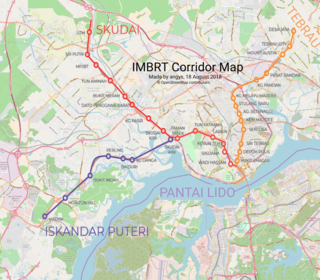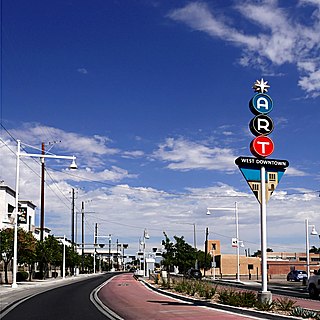Related Research Articles

Bus rapid transit (BRT), also called a busway or transitway, is a bus-based public transport system designed to have better capacity and reliability than a conventional bus system. Typically, a BRT system includes roadways that are dedicated to buses, and gives priority to buses at intersections where buses may interact with other traffic; alongside design features to reduce delays caused by passengers boarding or leaving buses, or paying fares. BRT aims to combine the capacity and speed of a metro with the claimed flexibility, lower cost and simplicity of a bus system.
Calgary Transit is the public transit agency which is owned and operated by the city of Calgary, Alberta, Canada. In 2019, an estimated 106.5 million passengers boarded approximately 1,155 Calgary Transit vehicles. It operates light metro (LRT), urban tramway, bus rapid transit (BRT), para-transit, and regular bus services. In 2021, the system had a ridership of 63,217,300, or about 268,800 per weekday as of the fourth quarter of 2021.

The Iskandar Malaysia Bus Rapid Transit (IMBRT) is a proposed bus rapid transit system to be built in and around Iskandar Malaysia, Johor, Malaysia. It will consist of trunk, direct, and feeder bus rapid transit corridors.

Van Ness Bus Rapid Transit is a bus rapid transit corridor on the Van Ness Avenue thoroughfare in San Francisco, California, United States. The 1.96-mile (3.15 km) line, which runs between Mission Street and Lombard Street has dedicated center bus lanes and nine stations. It was built as part of the $346-million Van Ness Improvement Project, which also included utility replacement and pedestrian safety features. Van Ness Bus Rapid Transit is used by several San Francisco Municipal Railway (Muni) lines including the 49 Van Ness–Mission, as well as three Golden Gate Transit routes.
Chennai BRTS was a bus rapid transit system taken up as an integrated part of Circular Corridor Project in India. Beginning at Adyar, the route will cover Saidapet, Jafferkanpet, Ramavaram, Puzhal, Manali, Chennai Central Railway Station, Lighthouse and will return to Adyar. The corridor will cover a distance of 70.3 kilometres (43.7 mi). The route of the elevated BRTS corridor was planned to run along the banks of Adyar river and Buckingham canal. The project was expected to be completed by 2013.
The Lagos Bus Rapid Transit System, also known as Lagos BRT, is a bus rapid transit system in Lagos State. It is regulated by LAMATA and currently operated by Primero Transport Services Limited.

Janmarg, also known as Ahmedabad BRTS, is a bus rapid transit system in Ahmedabad, Gujarat, India. It is operated by Ahmedabad Janmarg Limited, a subsidiary of Ahmedabad Municipal Corporation and others. It is designed by CEPT University. It was inaugurated in October 2009. The network expanded to 89 kilometres (55 mi) by December 2017 with daily ridership of 3,49,000 passengers. BRTS won several nation and international awards for design, implementation and operation. It was rated Silver on BRT Standard in 2013.
The Delhi BRTS was a bus rapid transit system in Delhi. The first route opened in 2008 ahead of the 2010 Commonwealth Games, which were held in the city. The project was well used but has been criticised for the difficulty of access to the bus platforms, which are in the middle of the road, for lack of enforcement and for the effect it has had on other motor traffic. A legal challenge was defeated in 2012. The Aam Aadmi Party Government had announced the scrapping of bus rapid transit system and it was dismantled in 2016, because of traffic congestion and accidents.

Visakhapatnam BRTS :-The implementation of the bus rapid transit system has been taken up as a high- capacity public transport system in Visakhapatnam keeping in view the projected multi-fold increase in traffic and constraints of road capacity. A Bus Rapid Transit System (BRTS) was approved for the city under the JNNURM. This project is under construction and will be completed by the end of 2010. The BRTS intends to increase use of public transport from the present share of about 30 per cent to 50 per cent by 2011.

The first bus rapid transit in Brazil (BRT) was built in 1974 in the city of Curitiba by the then mayor, architect Jaime Lerner, and became the second BRT in the world. The goal of the system is to provide high quality rail transit service to customers and at a comparable cost to that of a bus transit. Curitiba's success inspired the implementation of similar plans in more than 100 cities around the world, including the Brazilian cities of São Paulo, Rio de Janeiro, Belo Horizonte, Porto Alegre, Manaus, Goiânia, Aracaju, Salvador, Recife, and Brasília.

Bus rapid transit in New Jersey comprises limited-stop bus service, exclusive bus lanes (XBL) and bus bypass shoulders (BBS). Under the banner Next Generation Bus New Jersey Transit (NJT), the New Jersey Department of Transportation (NJDOT), and the metropolitan planning organizations of New Jersey (MPO) which recommend and authorize transportation projects are undertaking the creation of several additional bus rapid transit systems (BRT) in the state. In 2011, NJT announced that it would equip its entire bus fleet with devices for real-time locating, thus creating the basis for "next bus" scheduling information at bus shelters. The introduction and expanded use of bus rapid transit in Garden State is part of worldwide phenomenon to bring mass transit to heavily trafficked corridors in both high and medium density areas as a cost-saving, and sometimes more flexible, alternative to rail transportation, thus reducing automobile dependency and traffic congestion.

The A-Line is a proposed rapid transit line running along James Street in downtown and Upper James Street on the escarpment in Hamilton, Ontario. It is part of Hamilton's proposed BLAST network, involving four other rapid transit corridors. It is identified by Metrolinx in its regional transportation plan The Big Move as a project to be completed by 2023. The route is currently served by Hamilton Street Railway's Route 20 A-Line Express bus.
Bhopal BRTS is a bus rapid transit system in Bhopal, located in the state of Madhya Pradesh. The construction is funded by the Central Government under its flagship JnNURM. Unlike most of BRT projects in India which are designed to cater the transportation needs of suburban parts of the city, Bhopal BRTS is designed mainly to serve the Central business districts (CBDs). It started its operation with a fleet of just 30 buses in 2006, after receiving JnNURM Sanction, has grown to 225 buses comprising AC and Non AC Low Floor Buses.

The BRT Standard is an evaluation tool for bus rapid transit (BRT) corridors around the world, based on international best practices. The Standard establishes a common definition for BRT and identifies BRT best practices, as well as functioning as a scoring system to allow BRT corridors to be evaluated and recognized for their superior design and management aspects.

Albuquerque Rapid Transit, also known as ART, is a bus rapid transit (BRT) system serving the Central Avenue corridor in Albuquerque, New Mexico, United States. There are two lines running between Tramway Boulevard, the Central and Unser Transit Center (CUTC), and the Uptown Transit Center (UTC). It was built in 2016–17 and began limited operation in November, 2017, but was subsequently delayed for over two years due to problems with the stations and buses. After the original fleet of electric buses was replaced with diesel buses, the line began regular service on November 30, 2019.

Rainbow BRTS is a bus rapid transit system in the city of Pune. The system is operated by the Pune Mahanagar Parivahan Mahamandal Limited (PMPML). The infrastructure has been developed by the Pune Municipal Corporation & Pimpri Chinchwad Municipal Corporation, Pune. The project currently envisages 113 km of dedicated bus corridors along with buses, bus stations, terminals and intelligent transit management system.
The Lagos Metropolitan Area Transport Authority is the Lagos State Government agency created to coordinate transport planning, policies, and public transport infrastructure implementation in the Lagos Metropolitan Area, Nigeria. The organisation oversees wide range of transport planning and implementation of transport strategies and plans in Lagos, as well as the Lagos Rail Mass Transit and the Lagos Bus Rapid Transit System. It is based in Ikeja.

Zhengzhou Bus Rapid Transit is a bus rapid transit system in Zhengzhou, the capital of Henan Province in the People's Republic of China. The system has 5 main trunk routes with dedicated bus lanes along with a number of feeder routes that run for a portion of the corridor and serves other areas.
TransPeshawar or Peshawar BRT is a bus rapid transit system in Peshawar, capital of Pakistan's Khyber Pakhtunkhwa (KP) province. TransPeshawar BRT system consists of two parts: the first encompasses an east-west corridor served by 32 stations on a dedicated lane for exclusive use by buses, while the second part consists of a network of feeder routes in which buses can enter and exit the system to travel on city streets. The system was inaugurated on August 13, 2020, and is the fourth BRT system in Pakistan.